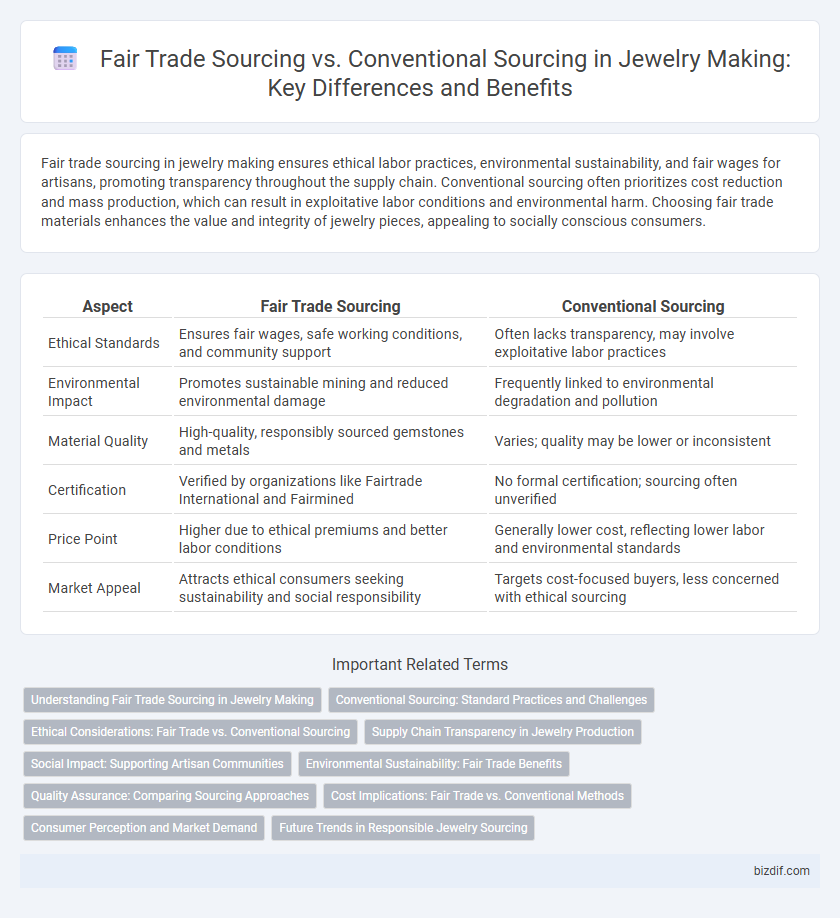Fair trade sourcing in jewelry making ensures ethical labor practices, environmental sustainability, and fair wages for artisans, promoting transparency throughout the supply chain. Conventional sourcing often prioritizes cost reduction and mass production, which can result in exploitative labor conditions and environmental harm. Choosing fair trade materials enhances the value and integrity of jewelry pieces, appealing to socially conscious consumers.
Table of Comparison
| Aspect | Fair Trade Sourcing | Conventional Sourcing |
|---|---|---|
| Ethical Standards | Ensures fair wages, safe working conditions, and community support | Often lacks transparency, may involve exploitative labor practices |
| Environmental Impact | Promotes sustainable mining and reduced environmental damage | Frequently linked to environmental degradation and pollution |
| Material Quality | High-quality, responsibly sourced gemstones and metals | Varies; quality may be lower or inconsistent |
| Certification | Verified by organizations like Fairtrade International and Fairmined | No formal certification; sourcing often unverified |
| Price Point | Higher due to ethical premiums and better labor conditions | Generally lower cost, reflecting lower labor and environmental standards |
| Market Appeal | Attracts ethical consumers seeking sustainability and social responsibility | Targets cost-focused buyers, less concerned with ethical sourcing |
Understanding Fair Trade Sourcing in Jewelry Making
Fair trade sourcing in jewelry making ensures that gemstones and metals are obtained through ethically responsible practices, promoting fair wages and safe working conditions for miners and artisans. This approach supports sustainable environmental practices and transparency in supply chains, contrasting with conventional sourcing, which often neglects worker rights and environmental impact. Understanding fair trade sourcing empowers consumers to make informed choices that contribute to social equity and ecological stewardship within the jewelry industry.
Conventional Sourcing: Standard Practices and Challenges
Conventional sourcing in jewelry making often relies on established supply chains that prioritize cost efficiency and volume over ethical considerations, leading to environmental degradation and labor exploitation. Standard practices typically involve mining operations with limited transparency and minimal regulatory oversight, resulting in significant social and ecological impacts. Challenges include addressing issues like conflict minerals, lack of traceability, and unequal power dynamics within the conventional gemstone and metal markets.
Ethical Considerations: Fair Trade vs. Conventional Sourcing
Fair trade sourcing in jewelry prioritizes ethical labor practices and environmental sustainability, ensuring artisans receive fair wages and work in safe conditions. Conventional sourcing often overlooks these standards, leading to exploitative labor and environmental harm in mining regions. Choosing fair trade materials supports transparent supply chains and promotes social responsibility within the jewelry industry.
Supply Chain Transparency in Jewelry Production
Supply chain transparency in jewelry production is significantly enhanced through fair trade sourcing, which ensures ethically mined materials and traceable origins from mine to market. Conventional sourcing often lacks detailed documentation, leading to risks of conflict minerals and unethical labor practices. Implementing transparent supply chains with verified certifications helps artisans and consumers make responsible choices while promoting sustainable jewelry craftsmanship.
Social Impact: Supporting Artisan Communities
Fair trade sourcing in jewelry making ensures artisans receive fair wages and work under safe conditions, significantly improving their quality of life. This approach empowers communities by preserving traditional craftsmanship and promoting economic independence. Conventional sourcing often overlooks these social benefits, focusing primarily on cost reduction rather than artisan welfare.
Environmental Sustainability: Fair Trade Benefits
Fair trade sourcing in jewelry making reduces environmental impact by promoting sustainable mining practices and minimizing harmful chemicals used in metal extraction. This approach supports ecosystem preservation through responsible waste management and reduced deforestation compared to conventional sourcing methods. Certified fair trade materials also encourage transparency and traceability, ensuring environmental sustainability throughout the supply chain.
Quality Assurance: Comparing Sourcing Approaches
Fair trade sourcing in jewelry making ensures quality assurance by adhering to ethical standards, promoting transparency, and sourcing materials from artisans who use sustainable methods, resulting in higher craftsmanship and traceable origins. Conventional sourcing often prioritizes cost efficiency and volume, which can compromise material consistency and reduce oversight on labor practices. Comparing these approaches highlights that fair trade sourcing typically delivers superior quality assurance through rigorous ethical and environmental criteria.
Cost Implications: Fair Trade vs. Conventional Methods
Fair trade sourcing in jewelry making often involves higher upfront costs due to ethical labor practices, sustainable materials, and transparent supply chains, which can increase production expenses compared to conventional sourcing methods. Conventional sourcing typically relies on mass extraction and lower labor costs, resulting in cheaper raw materials but potentially contributing to environmental degradation and labor exploitation. Investing in fair trade materials can enhance brand value and consumer trust, ultimately offsetting higher costs through premium pricing and market differentiation.
Consumer Perception and Market Demand
Fair trade sourcing in jewelry making significantly enhances consumer perception by emphasizing ethical labor practices and environmental sustainability, attracting socially conscious buyers. Market demand for fair trade jewelry has surged as consumers increasingly prioritize transparency and responsible sourcing over conventional methods associated with exploitative labor and ecological harm. This shift drives brands to adopt fair trade practices to meet growing expectations for ethical certification and traceability in the global jewelry market.
Future Trends in Responsible Jewelry Sourcing
Future trends in responsible jewelry sourcing emphasize fair trade principles to ensure ethical labor practices and environmental sustainability, contrasting with conventional sourcing often linked to exploitative mining and ecological harm. Increasing consumer demand for transparency drives the adoption of blockchain technology and certification systems to verify origins and supply chain integrity. Innovations in recycled materials and lab-grown gemstones are becoming integral to reducing the industry's carbon footprint and promoting circular economy models.
Fair trade sourcing vs conventional sourcing Infographic

 bizdif.com
bizdif.com